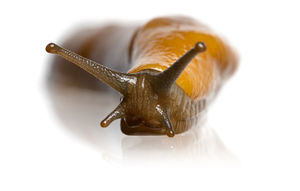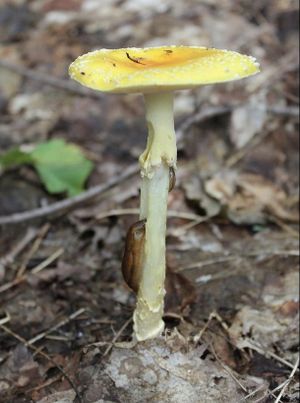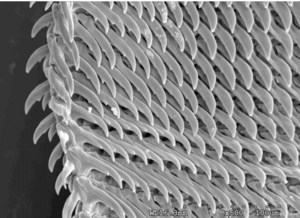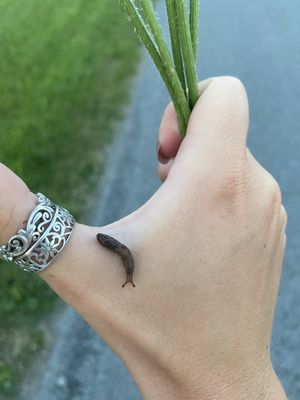Slugs

Description

Slugs are easily recognizable gastropods that belong to the phyla Mollusca [5]. While at first look slugs appear as slimy, simply-built creatures, they are actually composed of a variety of specific parts. At the head of a slug there are two pairs of tentacles that have the ability to retract into the body. The upper pair of tentacles are used to sense light, as there are eye spots on the ends [5]. The lower pair of tentacles are used by the slug to smell [5]. Directly behind a slug's head is a saddle-shaped structure known as the mantle [5]. The mantle covers the slug's genitals and anus along with a respiratory opening called the pneumostome, which is typically located on the right side of the mantle [5]. Behind the mantle is the slug's tail which, depending on the species of slug, will have a ridge down the middle known as a keel [5]. The underside of a slug is classified as the foot. The foot is capable of a series of rhythmic, muscular contractions which allow the slug to move freely [5]. To protect the foot tissue from being damaged during movement, the foot simultaneously secretes a layer of mucus which can be seen trailing behind a moving slug [5]. The rest of the slug's body will also produce mucus to protect the soft tissues exposed by a lack of a shell from desiccation [5]. Lastly, some slug species possess an internalized remnant of a shell, known as the vestigial shell which acts as an organ to store calcium salts [5].
Habitat
Slugs need a moist environment in order to survive due to their soft, moist body tissue which is prone to desiccation [6]. Because of this, most slugs live underground in cool, damp soils or can be found under mulch or the underside of decaying logs during dry spells. [6]. If a dry period persists for too long, slugs will encase themselves in a paper-like cocoon until it is over, which is a process known as aestivation [6]. Because of these requirements, slugs are most often found in temperate or tropical forests where there is plenty of moisture and moist areas to retreat to during dry spells.
Diet and Behavior
Slugs grind up their food using their jaw and a radula, which is a flexible band comprised of thousands of microscopic teeth [1]. The jaw cuts of large pieces of food that the radula will then scrape food particles from [1]. Most species of slugs are generalists, meaning they will eat a wide array of organic materials in order to sustain themselves [5]. Food sources range from mushrooms, living plants such as garden vegetables or flowers, lichen, and sometimes even carrion [5].

Slugs are typically nocturnal creatures, but can occasionally be seen during daytime if there are damp weather conditions [2]. They are also highly susceptible to changing temperatures in the environment [2]. Slugs will become more active as temperatures fall at nighttime, however; they rarely withstand freezing temperatures [2]. Some slug species will hibernate during the winter instead of dying off, but usually winter marks the end of their life cycle [5]. The optimal temperature range for maximum slug activity falls between 17 and 18°C [2]. Slugs display unique behaviors, especially when being threatened. If a threat is sensed, a slug will retract its body into a compact, circular shape to minimize damage [5]. While doing this, slugs will also firmly bind themselves to the surface they are on using their mucus in an attempt to prevent removal from the environment [5]. The excess mucus produced during this process also makes slugs more difficult to grasp by potential predators while also producing an unpleasant taste [5]. In some cases, slugs are even able to incapacitate certain predators (insects in this case) by using their mucus to create a sticky trap to immobilize the predator [5]. Some slug species will even go as far as to self-amputate portions of their body such as the tail in order to escape a predator [5]. Apart from being threatened, slugs will also display highly aggressive behaviors when competing with other slugs for resources, especially if they are scarce due to seasonality [5].
Life Cycle

Slugs are hermaphrodites which means one individual possesses both male and female reproductive organs [4]. Despite this, slugs will still mate with one another, resulting in both individuals producing fertile offspring. Slugs lay batches of eggs at a time in moist crevices underground or in decaying wood, with batches ranging in size from 10 to 50 eggs [4]. Slug eggs are spherical, gelatinous, and colored white or gold in appearance [4]. If the weather is warm enough, eggs can hatch as early as 10 days, but can take up to 100 days if the weather is not favorable [4]. From a hatched egg will emerge an immature slug which is similar to adult slugs in color, but is much smaller and more vulnerable to environmental conditions and predators [4]. After hatching, it will take roughly one year or less for a slug to reach maturity [4]. Once a slug reaches adulthood, its lifespan can last up to two years if conditions are favorable [4]. Most slug deaths occur due to cold weather, dry conditions, the presence of salt as slugs are comprised of mostly water, or predators [4].
Ecological Role
Slugs play a pivotal role in the environments of which they are present. They provide an abundant, protein rich food source for a variety of predators, from toads to shrews, foxes, and an array of different bird species [3]. Slugs are mainly important because they provide a food source for predators which are key control methods for other pests in the environment [3]. For example, if toads are attracted to an area due to high slug populations, they will also consume pests such as mosquitos that are present, helping to maintain a more balanced ecosystem [3]. Slugs are also important because they can act as decomposers. For example, slugs will eat a variety of rotting plants, animal droppings, or even carrion, resulting in the breakdown of organic material and a release of nutrients back into the soil [3].
References
[1] A Microscopic Look at Snail Jaws | Natural History Museum. (n.d.). . https://nhm.org/stories/microscopic-look-snail-jaws.
[2] Dainton, H. 1954. The activity of slugs. I. The induction of activity by changing temperatures. J. Exp. Biol:165.
[3] Ecological Benefits of Slugs. (n.d.). . https://budgeting.thenest.com/ecological-benefits-slugs-31334.html.
[4] Life Cycle of Slugs. (2017). https://www.gardenguides.com/13406265-life-cycle-of-slugs.html.
[5] Slug. (2021). https://en.wikipedia.org/wiki/Slug#Feeding_habits.
[6] Slug and Snail Biology. (2021). http://www.allaboutslugs.com/slug-and-snail-science/slug-biology-2/.